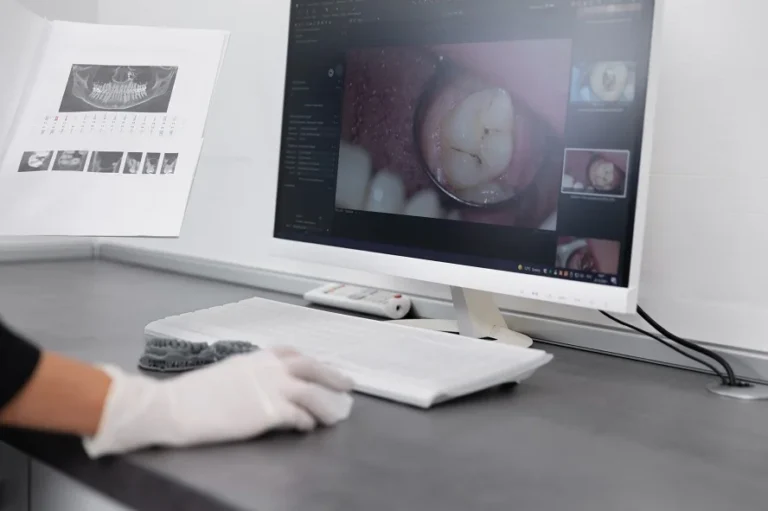Intraoral cameras have revolutionized dental care by providing a clear view of the mouth’s interior. These small, handheld devices capture high-resolution images, allowing dentists to diagnose issues more accurately and engage patients in their treatment plans. Understanding how intraoral cameras work not only enhances patient care but also empowers individuals to take charge of their oral health.
Images from intraoral cameras can be easily shared with patients through monitors in the examination room. This immediate feedback aids in patient education, allowing individuals to visualize their oral health status. Dentists can also store and compare images for ongoing treatment assessments.
Intraoral cameras, such as the ProDENT intraoral camera, improve diagnostic accuracy by revealing issues such as cavities, plaque buildup, and gum disease at early stages. Their small size and maneuverability allow for easy access to hard-to-reach areas in the mouth, making them an invaluable tool for both diagnosing and monitoring dental conditions.
Table of Contents
Components of Intraoral Cameras
Intraoral cameras consist of several key components that work together to produce high-quality images of the oral cavity.
Camera Lens and Image Sensors
The camera lens captures images at close range, providing dentists with a magnified view of teeth and gums. High-quality lenses improve detail visibility, allowing for effective diagnosis. Image sensors convert light into electronic signals, producing digital images. Various lens types, including wide-angle and macro lenses, allow for versatile imaging depending on the specific dental procedure being performed.
Lighting Mechanisms
Lighting mechanisms within intraoral cameras illuminate the oral cavity. These cameras typically use LED lights, which provide bright and even illumination without generating excessive heat. Proper lighting ensures the captured images reveal true colors and surface conditions, aiding in accurate assessments. Some cameras feature adjustable lighting controls, allowing practitioners to optimize brightness based on individual patient needs and specific areas being examined.
Functionality of Intraoral Cameras
Intraoral cameras improve dental diagnostics through advanced imaging technology, allowing for efficient and detailed examinations of patients’ oral health.
Image Capture Process
Intraoral cameras utilize a camera lens positioned close to teeth and gums to capture images. Light enters the lens, illuminating the oral cavity while the camera converts the reflected light into electronic signals. High-resolution sensors generate clear, magnified images, which can display minute details. The cameras may feature different lens types, such as wide-angle or macro lenses, depending on the specific imaging needs during procedures. Patients can view real-time images projected onto a screen, enhancing their understanding of their dental health.
Data Transmission and Storage
Intraoral cameras transmit captured images to a computer or display unit via wired or wireless connections. This digital transmission allows for instant access to images, enabling dentists to discuss findings with patients immediately. Images are stored electronically in dental practice management software, facilitating easy retrieval and comparison over time. Dentists can track changes in a patient’s oral health by reviewing past images, aiding in effective treatment planning and monitoring. This efficient data storage also simplifies sharing images with specialists when necessary.
Advantages of Using Intraoral Cameras
Intraoral cameras offer significant benefits in dental practices. They improve communication between dentists and patients, improve diagnostic accuracy, and promote better treatment outcomes.
Enhanced Patient Communication
Intraoral cameras facilitate real-time visualization during dental appointments. Patients see high-resolution images of their teeth and gums projected onto a screen. This visual aid promotes understanding of dental conditions, making it easier for patients to engage in their treatment plans. Clear images address questions and reduce anxiety, fostering trust between the dentist and patient.
Improved Diagnostic Accuracy
Intraoral cameras contribute to increased diagnostic precision. Their magnification capabilities enable dentists to detect issues such as cavities, plaque buildup, and early signs of gum disease that may go unnoticed during a routine examination. High-quality images allow for detailed assessments and comparisons over time, leading to informed treatment decisions. The ability to capture and store images electronically streamlines the diagnostic process and enhances overall patient care.
Conclusion
Intraoral cameras are transforming dental care by enhancing diagnostic capabilities and fostering better communication between dentists and patients. Their ability to capture detailed images allows for early detection of dental issues and empowers patients to take an active role in their oral health. With real-time imaging and easy data sharing, these tools not only improve treatment planning but also build trust and reduce anxiety during dental visits. As technology continues to advance, intraoral cameras will play an increasingly vital role in delivering high-quality dental care.
For more insights into innovative dental technologies and their benefits, visit NextMagazine and stay informed about the latest in healthcare advancements.

